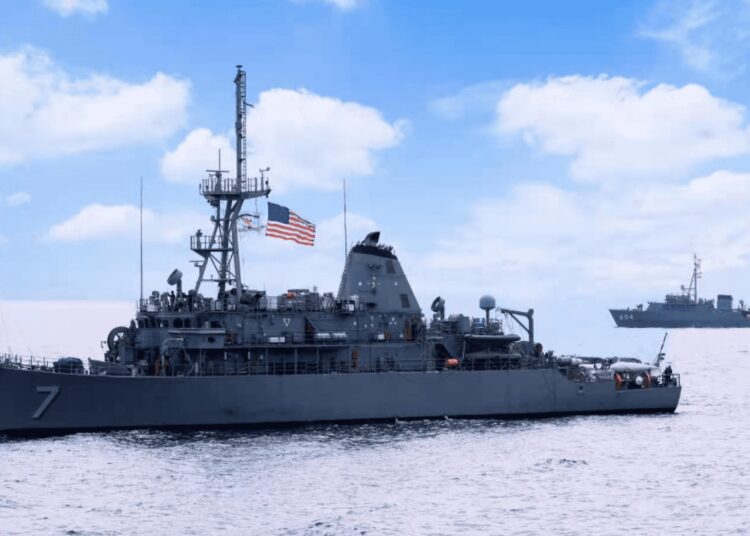This article explores the strategies and countermeasures involved in submarine warfare. It highlights the advancements in technology that have made submarines stealthier and deadlier. The strategies employed in submarine warfare include offensive operations, intelligence gathering and surveillance, and anti-submarine warfare. These strategies allow submarines to strike at enemy targets, gather valuable information covertly, and neutralize enemy submarines. To counter the threat of submarines, defense forces deploy countermeasures such as sonar systems, maritime patrol aircraft, submarine sensors and decoys, and undersea warfare systems. These countermeasures aid in detecting and tracking submarines, neutralizing them, and protecting surface vessels. The article concludes by emphasizing the continuous innovation and adaptation required to maintain control over the world’s oceans in the face of evolving submarine technology.
Deep Dive into Submarine Warfare: Strategies and Countermeasures
Introduction
Submarine warfare has come a long way since its inception in the early 20th century. With advancements in technology, submarines have become stealthier, faster, and deadlier. Today, these underwater vessels play a crucial role in modern naval warfare, with strategic advantages that can potentially shift the balance of power on the seas. In this article, we will explore the strategies employed in submarine warfare and the countermeasures used to mitigate their threats.
Submarine Warfare Strategies
Submarines are utilized by naval forces around the world for a wide array of missions, including intelligence gathering, surveillance, and, most significantly, offensive capabilities. The strategies employed by submarines can be broadly classified as:
1. Offensive Operations
Offensive submarine operations involve leveraging the stealth and surprise elements of submersible vessels to strike at enemy targets. Submarines equipped with guided missiles or torpedoes can effectively engage enemy vessels, surface ships, or even coastal targets. The ability to operate stealthily beneath the surface makes submarines an imposing threat, as they can approach undetected and launch devastating attacks.
2. Intelligence Gathering and Surveillance
Submarines are also deployed for intelligence gathering and reconnaissance missions, where they gather valuable information about enemy fleet movements, coastal defenses, and underwater topography. Advanced sensors, communication systems, and periscope technology enable submarines to collect crucial data covertly, allowing friendly forces to make informed decisions and respond effectively.
3. Anti-Submarine Warfare (ASW)
Another crucial submarine warfare strategy is its application in anti-submarine warfare. Submarines equipped with sonar systems and torpedoes can actively hunt down enemy submarines, disrupting their operations and protecting friendly forces. ASW operations involve strategic positioning, active and passive sonar techniques, and the coordination of surface vessels or aircraft to neutralize enemy submarines.
Countermeasures in Submarine Warfare
Given the potent capabilities of submarines, defense against these underwater threats requires strategic planning and the deployment of countermeasures. Some key countermeasures used to neutralize submarines are:
1. Sonar Systems
Sonar systems play a pivotal role in detecting and tracking submarines. Active sonar emits sound waves and analyzes the returning echoes to detect the presence of underwater vessels. Passive sonar, on the other hand, listens for the sounds emitted by submarines, such as propeller noise or machinery, and uses these acoustic signatures to locate them. Combining both active and passive sonar approaches strengthens the effectiveness of detection and tracking capabilities.
2. Maritime Patrol Aircraft
Maritime patrol aircraft (MPA) are instrumental in anti-submarine warfare, complementing the capabilities of surface vessels. Equipped with advanced radar, sonobuoys, and magnetic anomaly detectors, MPAs patrol vast stretches of ocean, hunting for submarines. These aircraft can drop sonobuoys into the water, which transmit underwater sounds back to the aircraft, aiding in locating enemy submarines. Furthermore, MPAs can deploy depth charges or torpedoes to neutralize detected submarines.
3. Submarine Sensors and Decoys
Surface vessels can deploy various sensors and decoys to confuse and counter submarines. Acoustic sensors mounted on buoys or ships can transmit misleading sounds to confuse enemy submarines, making it difficult for them to differentiate between real targets and decoys. Similarly, expendable acoustic decoys can be deployed to lure torpedoes away from the intended targets, increasing the chances of survival for surface vessels.
4. Undersea Warfare Systems
Advancements in technology have resulted in the development of sophisticated undersea warfare systems. These systems employ underwater drones or remotely operated vehicles (ROVs) to locate and neutralize enemy submarines. These ROVs can manipulate torpedoes, attach markers for tracking, or even deploy explosives while keeping friendly forces at a safe distance.
Conclusion
Submarine warfare continues to evolve rapidly, with submarines playing a vital role in modern naval operations. The strategies employed by submarines, including offensive operations, intelligence gathering, and anti-submarine warfare, pose significant threats to naval forces. Nevertheless, with the effective implementation and deployment of countermeasures such as sonar systems, maritime patrol aircraft, submarine sensors, and undersea warfare systems, the risks associated with submarines can be mitigated. The endless cat-and-mouse game between submarines and their adversaries ensures that naval forces must continuously innovate and adapt their strategies to maintain control over the world’s oceans.












